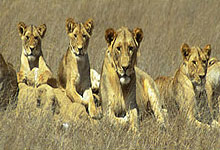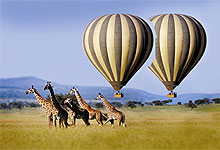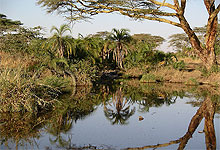Serengeti
National Park - Tanzania
Serengeti
National Park View Rates, Discounted Prices - Book &
Save Now!
Serengeti
National Park
is Tanzania's largest and best-known National Park,
with a massive concentration of migratory animals who
move around the park according to the availability of
food.
The
Serengeti ecosystem extends beyond the National Park
to include several other conservation areas and reserves,
including the Masai Mara in Kenya. It is through these
extensive protected areas that a million or more wildebeest
and hundreds of thousands of zebra and impala, complete
their great circulatory migration.
Serengeti means "endless plain" in the Maasai
language and much of the landscape epitomizes what we
have come to expect from an East African safari - vast
open savannahs dotted with acacia trees and a few rocky
hillocks.
Serengeti
National Park Animals & Birds - The Migration
It
is hard to predict exactly where the migration will
be at a certain time, because the animals are driven
purely by the search for food, and if the rains come
when they are supposed to, the herds follow a predictable
pattern. In May the herds graze along the western corridor
between the Grumeti and Mbalageti Rivers, and commence
their mating season.
Then
in June or July they split up and some continue west,
while others head due north and hundreds of thousands
move steadily north-west towards the long golden grass
of the Masai Mara. They graze on both sides of the Mara
River for several months and then head south again in
about October.
They
return to the short grass plains of the southern Serengeti,
where during December to April they give birth. Then
the endless cycle of life begins again. The numbers
of animals that complete this migration is incredible
- 1.5 million wildebeest, 300,000 Thomson's gazelle
and 250,000 zebras chomp and grunt their way through
the plains.
Where
there is such a large mobile meat supply there are predators
and the Serengeti is renowned for its impressive lion
sightings. Silver-backed jackals, spotted hyenas, cheetah,
eagles and vultures are also avid consumers of this
endless source of meat and little goes to waste.
Some
of the Serengeti's largest buffalo herds are to be found
in the pristine woodlands to the north and elephants
abound in this area too. For excellent year round game
viewing the Seronera valley in the centre of the park
has abundant grazing and considerable numbers of animals
including giraffes, warthogs, reedbucks and many other
species that sustain resident leopards and large prides
of lions.
In
the south is the saline Lake Ndutu which attracts throngs
of flamingoes and in the west the Grumeti River contains
some of the largest Nile crocodiles you will ever see.

A
pride of Lions in the Serengeti National
Park
|

Hot Air Ballooning
in the Serengeti National Park
|

River
Seronera in The Serengeti National Park
|
Serengeti
National Park Seasons
For
much of the year temperatures remains between 70-80°F
(21-27°C) but nights and early mornings get colder
in the months of June, July and August.
Rainy
Season: The short rains are in November and
December and the long rains fall from March to May,
with April and May being the height of the rainy season.
Dry
Season: June to October is usually dry, as
is January and February.
Serengeti
National Park Highlights
• Prides of lions
• Hot air ballooning
•
The great migration
• Vast open spaces and big sky
• Excellent choice of safari lodges
Serengeti National Park Accommodation |
|
Serengeti
National Park Safaris & Tours |
|
Booking
& Reservations for Serengeti
National Park is located 335 Kilometers (208 Miles)
from Arusha, stretching north to Kenya and bordering
Lake Victoria to the west -
Tanzania
Booking
Office Tel: +
254 (0) 20 2437871
Mobile : + 254 - 721242711
Email:
[email protected]
